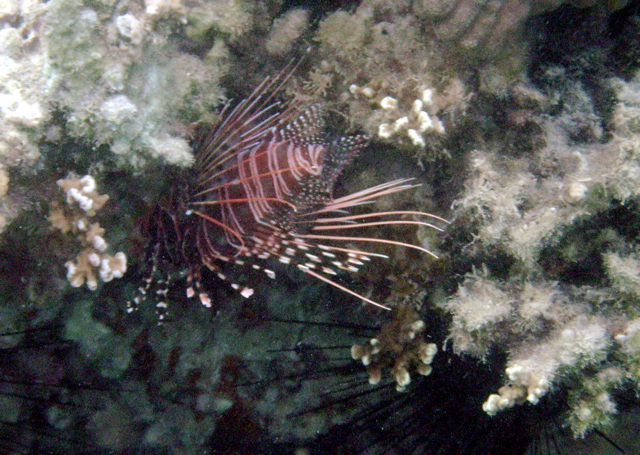Published in the Ocean Watch column, Honolulu Star-Advertiser © Susan Scott
July 11, 2008
A friend sent me a link to a news report that on the South Atlantic coast of the U.S., the lion-fish population is out of control. Film clips showed divers coming up with sacks of lion-fish, a fraction of what’s out there. This alien species got a fin-hold in the area in the ’90s, the reporter said, and is now multiplying like mad.
Alien species? I didn’t know. These popular aquarium fish are native only to the Indian and Pacific oceans.
Now, however, divers from Florida to North Carolina and in the Bahamas, Bermuda and Cuba are commonly finding lion-fish. Researchers believe the species will keep spreading, eventually populating most of the Caribbean Sea, Gulf of Mexico and Florida Keys.
The resplendent red, white and maroon striped fish, prized for aquariums, have become pests.
It’s not the lion-fish’s fault. In 1992, Hurricane Andrew introduced this species to the Atlantic by breaking a beachside aquarium containing six lion-fish. And off they went into the warm Gulf Stream, reproducing along the way.
Lion-fish are broadcast spawners, spewing their gametes into the water and letting nature do the pairing.
Lion-fish bear venomous spines for defense, but it’s not their venom that makes lion-fish such undesirables. It’s their eating habits and lack of predators.
As one author puts it, lion-fish are gluttons. These fish swim slowly, fanning their long pectoral fins over the reef to flush out and corner crabs, shrimp and small fish.
This is fine when lion-fish numbers are low, as is usual in Hawaii and on other Indo-Pacific reefs. Lion-fish are rare enough that seeing one while diving is always a thrill.
But when lion-fish numbers are high, they form gangs. Lion-fish share space with other members of their species and cooperate in hunting and herding. They also have remarkably large, expandable mouths and snap up anything they come across.
During the day, lion-fish rest in caves and under ledges, usually upside down with their whiskery spines sticking out. At night the fish come out to hunt.

Lionfish hiding upside down in the daytime. Uturoa, Raiatea, French Polynesia.
Photo courtesy Scott Davis.
Since Atlantic marine animals haven’t evolved to recognize lion-fish as predators, small fish and invertebrates there are like lion-fish popcorn.
There’s little to stop them. Even in their native waters, lion-fish’s only predators are sharks and cornetfish.
As unlikely as it seems, cornetfish in the Red Sea prey on lion-fish. It’s hard to picture that long skinny fish eating the wide spiky one, but it’s well documented there. No one knows, though, if Atlantic, Caribbean or Indo-Pacific cornetfish eat lion-fish.
Hawaii hosts one endemic lion-fish, also called a turkey fish or nohu pinao, which also means “dragonfly” in Hawaiian. Turkey fish are now absent on some Hawaii reefs from over-collecting.
Our species (sphex) grows to 8 inches long. The species loose in the Atlantic (volitans) grows to nearly twice that, 15 inches.
The beautiful lion-fish make interesting pets, but as feral fish in foreign waters, they’re trouble, clearing the reefs of their native residents.
There’s no good way to eradicate an alien marine fish once it has taken hold. But nature often has a way of checking runaway populations with disease, food limitations or reproductive failure.
Until something like that happens, though, lion-fish in the Atlantic are there to stay.